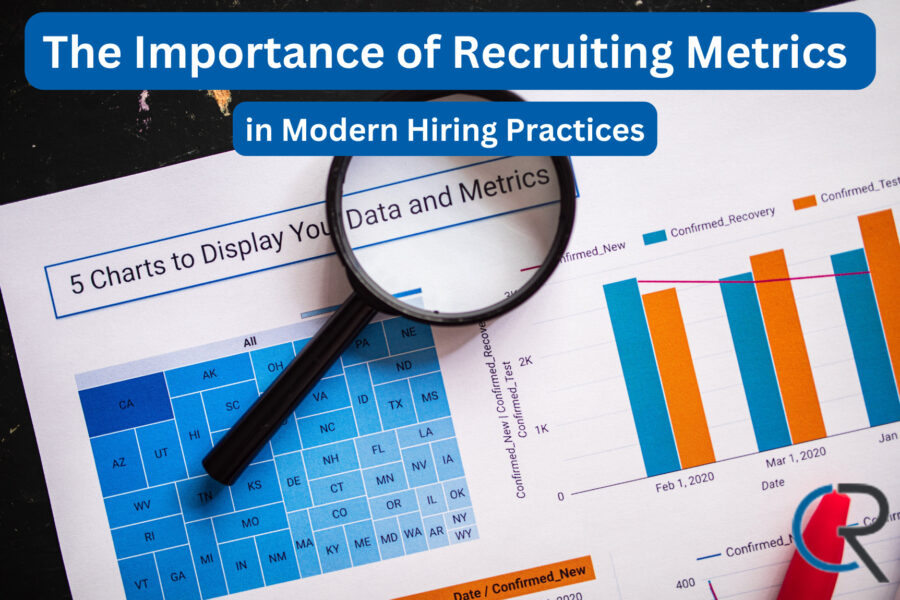Finding the right talent is hard. To be completely honest with you, some companies never figure it out.
The secret is to find the right talent that aligns with the company’s values and goals, and does so efficiently. This is where recruiting metrics come into play, transforming the art of hiring into a more precise science.
Understanding Recruiting Metrics
Recruiting metrics are data-driven measures used to evaluate and improve the effectiveness of the hiring process. These metrics encompass a variety of data points, from the time it takes to fill a position (Time to Fill) to the cost involved in hiring a candidate (Cost per Hire). They offer tangible insights into how efficiently and effectively a recruitment team operates.
Why are these metrics important? Simply put, they provide a factual basis for making informed decisions. In recruitment, intuition and experience are invaluable, but data brings an additional layer of accuracy and predictability. By analyzing these metrics, companies can identify strengths and weaknesses in their hiring process, make necessary adjustments, and ultimately, hire better candidates faster and more cost-effectively.
Why Measure Your Recruitment Efforts?
The essence of measuring recruitment lies in its impact on the business as a whole. Efficient recruitment processes save time and resources, which directly affects the company’s bottom line. Beyond financial implications, recruitment metrics influence the quality of hire, affecting team dynamics, productivity, and even company culture.
For instance, a high turnover rate might indicate issues with the hiring process or employee engagement strategies. Similarly, a prolonged Time to Fill might suggest the need to streamline the recruitment process or revisit the job description and candidate sourcing strategies.
In summary, recruiting metrics are not just numbers; they are insights that lead to more strategic, informed, and successful hiring decisions. As we delve deeper into the specifics of these metrics in the following sections, we’ll explore how they shape the future of talent acquisition and contribute to the overall success of an organization.
Key Recruiting Metrics to Monitor
Time to Fill is the most straightforward yet critical metric, it measures the number of days from when a job requisition is opened until an offer is accepted. This metric gives insight into the efficiency of the recruitment process. A longer time to fill can indicate challenges in sourcing candidates or inefficiencies in the recruitment pipeline.
Quality of Hire is a metric that looks at new hires, how long they stay, what impact they have in their positions, what their competencies are, and what sources they are coming from and why. Quality of hire metrics look at post-hire data and help you gauge how satisfied people are with the hires being made. It’s not an easy metric to apply but is worth the effort. GE CEO Jack Welch recommends measuring quality of hire and doesn’t accept excuses for not tracking it.
Candidate Satisfaction measures the experience of applicants throughout the recruitment process. This can be assessed through surveys and feedback forms post-interview. High candidate satisfaction can improve a company’s brand reputation and attract more qualified applicants.
Cost Per Hire calculates the total cost associated with the hiring process, including advertising fees, recruiter fees, and time spent by HR. Keeping track of your cost per hire helps in budgeting and identifying areas where the process can be made more cost-effective.
Application Completion Rate looks at the percentage of applicants who start the application process and complete it. A low completion rate might indicate that the application process is too long or complicated, potentially deterring qualified candidates.
Analyzing Hiring Effectiveness
Interpreting data from recruitment metrics involves looking beyond the numbers to understand their implications. For example, a low Time to Fill rate is generally positive, but if coupled with a low Quality of Hire, it might suggest hasty hiring decisions. Similarly, a high Cost per Hire could be justified if it results in hires of significantly higher quality.
Leveraging analytics in recruitment involves using data to identify trends, predict outcomes, and make informed decisions. For instance, if data shows a particular source consistently yields high-quality candidates, resources can be allocated accordingly. Analytics can also help in forecasting hiring needs and preparing proactively, rather than reacting to vacancies.
By monitoring these key metrics and analyzing them effectively, organizations can refine their recruitment strategies, leading to more efficient, cost-effective, and successful hiring processes. This not only enhances the immediate goal of filling positions but also contributes to the long-term success and stability of the company.
Best Practices in Recruitment Analytics
The integration of technology and software is a cornerstone of effective recruitment analytics. Modern HR tools and platforms offer sophisticated data analysis capabilities, enabling recruiters to track and evaluate metrics more accurately and efficiently. For instance, Applicant Tracking Systems (ATS) can automate the tracking of Time to Fill or Application Completion Rate, while analytics software can provide deeper insights into the data collected.
The key is to choose technology that aligns with the specific needs of the organization. This might include software for sourcing candidates, tools for conducting video interviews, or advanced analytics platforms that can predict hiring trends.
Recruitment is a dynamic field, and what works today may not be as effective tomorrow. Regularly updating and reviewing metrics ensures that recruitment strategies remain relevant and effective. This practice involves not just tracking metrics over time but also revisiting the definitions and methodologies used to ensure they still align with the organization’s goals.
For example, as the job market and candidate expectations evolve, measures of Candidate Satisfaction might need to be adjusted to reflect new standards or priorities. Similarly, advancements in recruitment technology might offer more efficient ways to measure metrics like Cost per Hire or Quality of Hire.
Future of Recruitment Metrics
The future of recruitment metrics is closely tied to the evolving landscape of the workforce and technology. One significant trend is the increasing importance of diversity and inclusion metrics. Organizations are now focusing on how effectively they reach diverse candidate pools and the impact of diversity on team performance and company culture.
Another emerging trend is the use of predictive analytics. Instead of simply analyzing past recruitment data, companies are using this data to predict future trends, such as which candidates are more likely to succeed in a role or which recruitment channels will yield the best results.
Artificial Intelligence (AI) and Machine Learning (ML) are set to revolutionize recruitment metrics. These technologies can analyze large datasets more efficiently than humans, identifying patterns and insights that might be missed otherwise. For example, AI can be used to predict candidate success based on historical data or to identify the most effective recruitment channels.
ML algorithms can also help in reducing biases in the hiring process by focusing on data-driven decision-making. This ensures a fairer, more equitable recruitment process and helps companies build more diverse and effective teams.
Conclusion
This exploration of recruitment metrics has highlighted their crucial role in modern hiring practices. The use of technology and regular updates of these metrics ensure that the recruitment process remains efficient and aligned with organizational goals.
Real-world case studies have shown the positive impact of effectively implementing and analyzing recruitment metrics, while emerging trends point towards an even more data-driven and technologically advanced future in recruitment.
Companies should embrace continuous improvement and learning in their recruitment processes, leveraging the latest trends and technologies. By doing so, they can not only enhance their immediate recruitment outcomes but also contribute to the long-term growth and success of their organization.
Are you looking to grow your team? Contact our team today and learn how we can help you hire employees who will help your business grow.
Page updated on December 4, 2023.


